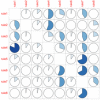A Comparison of Rule-based Analysis with Regression Methods in Understanding the Risk Factors for Study Withdrawal in a Pediatric Study
- PMID: 27561809
- PMCID: PMC5000469
- DOI: 10.1038/srep30828
A Comparison of Rule-based Analysis with Regression Methods in Understanding the Risk Factors for Study Withdrawal in a Pediatric Study
Erratum in
-
Corrigendum: A Comparison of Rule-based Analysis with Regression Methods in Understanding the Risk Factors for Study Withdrawal in a Pediatric Study.Sci Rep. 2017 May 2;7:39723. doi: 10.1038/srep39723. Sci Rep. 2017. PMID: 28462922 Free PMC article. No abstract available.
Abstract
Regression models are extensively used in many epidemiological studies to understand the linkage between specific outcomes of interest and their risk factors. However, regression models in general examine the average effects of the risk factors and ignore subgroups with different risk profiles. As a result, interventions are often geared towards the average member of the population, without consideration of the special health needs of different subgroups within the population. This paper demonstrates the value of using rule-based analysis methods that can identify subgroups with heterogeneous risk profiles in a population without imposing assumptions on the subgroups or method. The rules define the risk pattern of subsets of individuals by not only considering the interactions between the risk factors but also their ranges. We compared the rule-based analysis results with the results from a logistic regression model in The Environmental Determinants of Diabetes in the Young (TEDDY) study. Both methods detected a similar suite of risk factors, but the rule-based analysis was superior at detecting multiple interactions between the risk factors that characterize the subgroups. A further investigation of the particular characteristics of each subgroup may detect the special health needs of the subgroup and lead to tailored interventions.
Figures




References
-
- Greenland S., Gago-Dominguez M. & Castelao J. E. The value of risk-factor (“black-box”) epidemiology. Epidemiology 15, 529–535 (2004). - PubMed
-
- Evans L. K. Knowing the patient: the route to individualized care. J. Gerontol. Nurs. 22, 15–19; quiz 52 (1996). - PubMed
-
- Radwin L. & Alster K. Individualized nursing care: an empirically generated definition. Int. Nurs. Rev. 49, 54–63 (2002). - PubMed
-
- Ryan P. & Lauver D. R. The efficacy of tailored interventions. Journal of Nursing Scholarship 34, 331–337 (2002). - PubMed
-
- Whittemore R. Consequences of Not” Knowing the Patient”. Clinical Nurse Specialist 14, 75–81 (2000). - PubMed
Publication types
MeSH terms
Grants and funding
- U01 DK063821/DK/NIDDK NIH HHS/United States
- UC4 DK063863/DK/NIDDK NIH HHS/United States
- HHSN267200700014C/DK/NIDDK NIH HHS/United States
- U01 DK063861/DK/NIDDK NIH HHS/United States
- UL1 TR001427/TR/NCATS NIH HHS/United States
- U01 DK063790/DK/NIDDK NIH HHS/United States
- UL1 TR001082/TR/NCATS NIH HHS/United States
- UL1 TR000064/TR/NCATS NIH HHS/United States
- U01 DK063836/DK/NIDDK NIH HHS/United States
- U01 DK063829/DK/NIDDK NIH HHS/United States
- U01 DK063865/DK/NIDDK NIH HHS/United States
- UC4 DK095300/DK/NIDDK NIH HHS/United States
- UC4 DK063861/DK/NIDDK NIH HHS/United States
- UC4 DK063829/DK/NIDDK NIH HHS/United States
- UC4 DK063821/DK/NIDDK NIH HHS/United States
- UC4 DK117483/DK/NIDDK NIH HHS/United States
- UC4 DK063836/DK/NIDDK NIH HHS/United States
- UC4 DK112243/DK/NIDDK NIH HHS/United States
- UC4 DK063865/DK/NIDDK NIH HHS/United States
- U01 DK063863/DK/NIDDK NIH HHS/United States
- UC4 DK106955/DK/NIDDK NIH HHS/United States
- UC4 DK100238/DK/NIDDK NIH HHS/United States
LinkOut - more resources
Full Text Sources
Other Literature Sources
Research Materials

